I have noticed that not many people on here have pheasants, but for those who are just starting this breed I have created an info page on the Pheasant that has history of the bird, raising, flight pens, sites, incubation, photos, and other useful info.
History:
The Ringneck Pheasant (Phasianus colchicus) is a non-native animal to North America. They were imported from Asia (China) in the 1800's, but there were a few pairs of Blackneck Pheasants seen in 1733. Now, they are the most succesful non-native gamebird in America! They have adapted to life in the western states in large fields. The Ringneck was introduced into South Dakota in 1898, and can be recognized by many due to it's colorful plumage. Stocking efforts has kept this breed here to stay and efforts to preserving the land in which they live on.
Habitat:
Please look at this before you stock Pheasants into an area!
-EASTERN:
Pheasants will survive if there is substantial upland cover, known to hunters as "bird cover". Theses uplands need to be near or colose to swampy marsh areas, corn fields, and large ditches. In the North East, not many Pheasants make it through the winter as they are very tough for wildlife. Although, food plots planted for birds can help them survive harsh winters.
-WESTERN:
Western states have large fields of wheat, cover, food for winter, and all the essentials Pheasants need for surviving themselves. the large fields in the west provide both cover from predators and a lot of area to fly and/or run.
*Habitat needs*
- For nesting, brooding, and rearing in the wild hens need a medium to high grasses or crops
-Wetlands (as metioned above)
-Areas such as cattails, or switchgrass that will protect the birds from heavy snow.
-fields of Grains, Soybeans, Weeds, and crops to supply winter food. (this is why so many Pheasants stocked in east do not survive. Take note.)
Incubating Ringneck eggs:
Pheasants will begin to breed around March, the cockbirds will establish territories, fending off other males that want the same spot. A good ratio of cockbird to hens is 1:8, any more cockbirds will fight. Hens will lay with proper food (Layer pellet with corn ration, oyster shell free choice )
-The eggs will hatch better in a STILL AIR incubator as opposed to a forced air.
-Eggs in an incubator should be put in at 37.5*C, that was in my notes, so I haven't converted it to degrees Farenheit.
-Turning is required to prevent embryos from sticking from the side, Eggs that are hand turned should not be on the same side for two (2) consecutive nights on the same side.
-The humdity should be about 45-50%, and the birds will start hatching around the 24th day.
Raising Ringneck Pheasants:
(All information can be found on my website under Pheasant chick care)
-Heat. they like to be kept like chickens in about 90-95 degrees farenheit. make sure the chicks are not too hot; it could result in cannibalism. Also make sure they are not to cold. The could start piling.
-Space. Pheasant need a lot of space when they are young. If they are too crowded it could cause cannibalism. they need to .25 sq. feet for the first 2 weeks, 3-6 weeks .75 sq. feet per bird. Outdoor grow pens should give them about 15-20 sq.ft per bird.
-Water can be given in chick waterers. Make sure there are marbles in the waterers to make it shallow so the birds won't drown. Vitamins called terramycin can be put in the water if they are sick.
-Litter should be paper towels for the first week. After the first week they can be but on straw or pine shavings. Never use cedar, as it could kill the birds.
-food. Pheasant need a higher protein food. It could be a gamebird starter or just a higher percent protein. for my pheasant I use a 24%. some people use 28% I think 28% is better off for turkeys.
-Draft shields. draft shields are a circle that are put in the brooder to prevent piling in the corners. The draft shield should be a circle that is 2 feet in diameter for every 25 birds.
-At three weeks old they can range outside in a chicken wire pen during sunny days. Make sure the pen is covered so predators like hawks, coyotes, foxes, etc. can not get in, and so the Pheasant can't fly out. For this, I moved my pheasants into a pen in the garage, on nicer days I would open the garage door so they could get some fresh air.
-Red heat light. The birds get very aggresive if the have a bright light shining on them so it is a good idea to have a red 250 watt heat lamp.
-Turning off the light on sunny days will help a few things. 1.) It will help prevent any fighting going on. 2.) Help the pheasant get used to the idea of no heat. 3.) Save you money on your electicity bill.
-Going into the flight pen. At 6-8 weeks of age the Pheasant can go into the flight pen. Just make sure there is the proper cover needed.
Cannibalism:
Canniblism is very common in gamebirds like pheasant. If it is not caught in it's early stages it could be very bad later on. A good way to prevent cannibalism is to have enough space ofr them, have just the right tempature, and have a red heat lamp. My Pheasant started to become cannibalistic between 5-7 weeks. It stopped once we put them outside into the flight pen.
Note the blood on the wings, this was ten minutes after we put them into the pen:
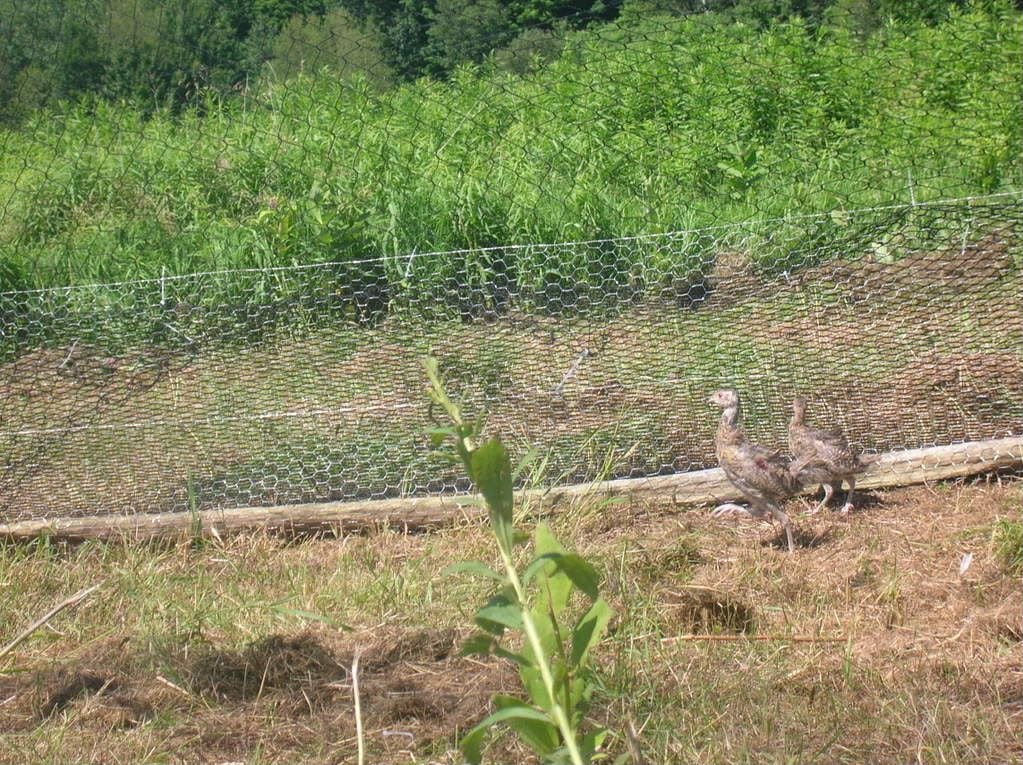
Flight Pens:
Flight pens are key to the pheasants survival in the wild. Flight pens should be made out of a mesh type of netting called flight netting. The pen should be big enough to give each pheasant 20-30 square feet of space. It should have enough cover (brush, shelters, tree branches, rocks, etc.) to protect it from the weather or predators that might get into the pen.
Pictures of my flight pen:
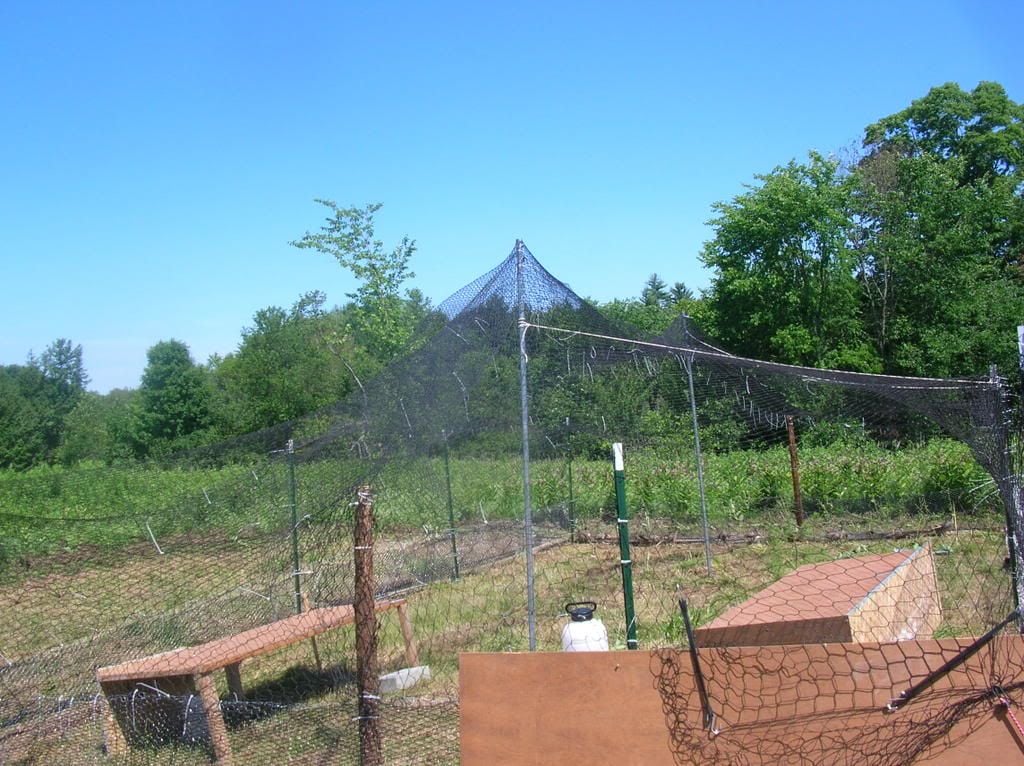

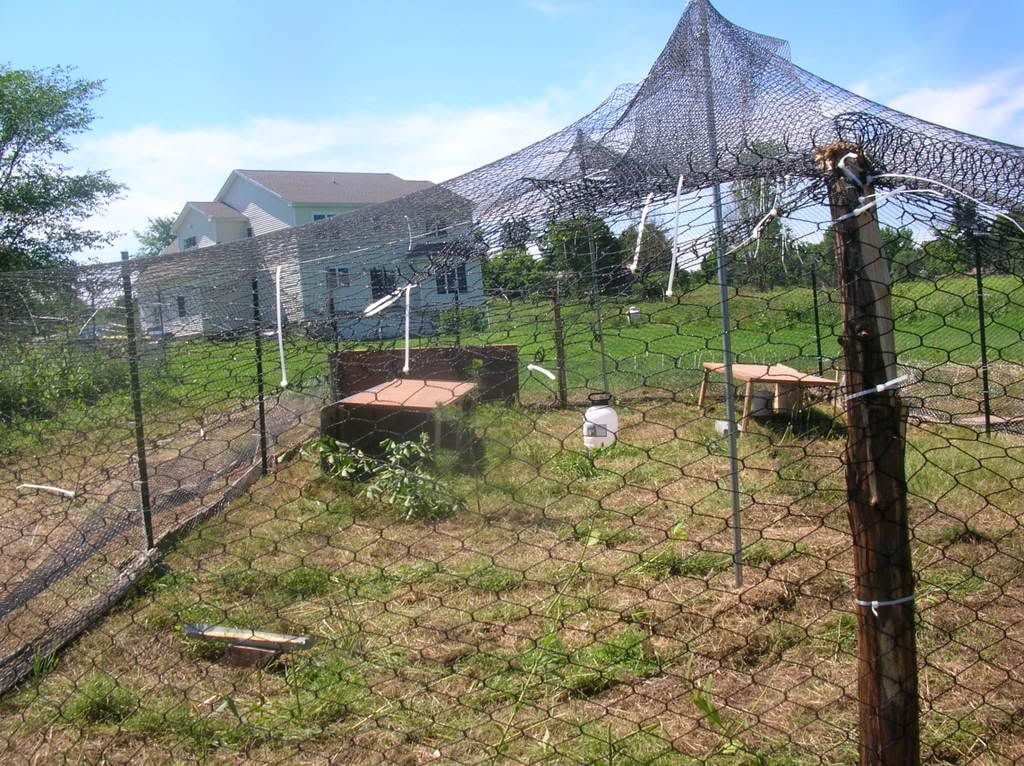
Releasing:
Pheasants should be released when they are matured, and are smart enough to be out in the wild without being killed. A good rule of thumb (Personal opinion) is when they have almost full green heads, around 20ish weeks.
About this age:
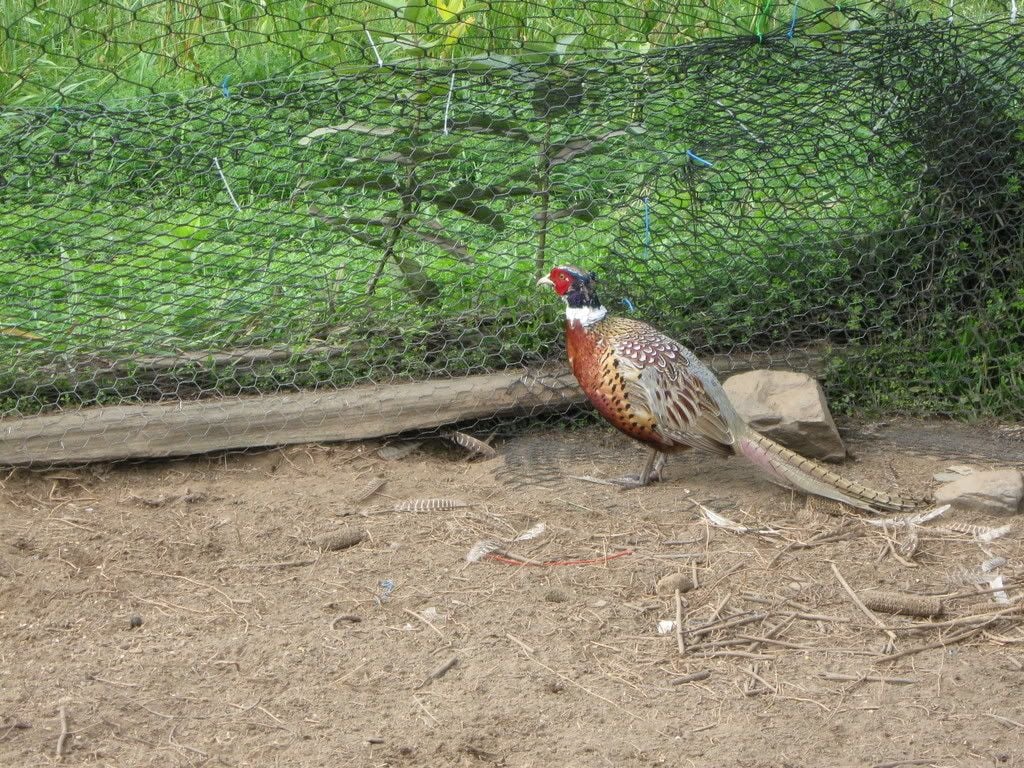
Telling gender at younger ages:
I saw with my birds that usually wattles will appear on a rooster around 9 weeks old, they grow quickly once they start, in a few weeks wattles turn to feathers, to green heads, then to longer tails.
Pheasants can also be sexed a hours old by patches under the eye, I have not seen how to do this yet. This bird is around 10-15 weeks old :
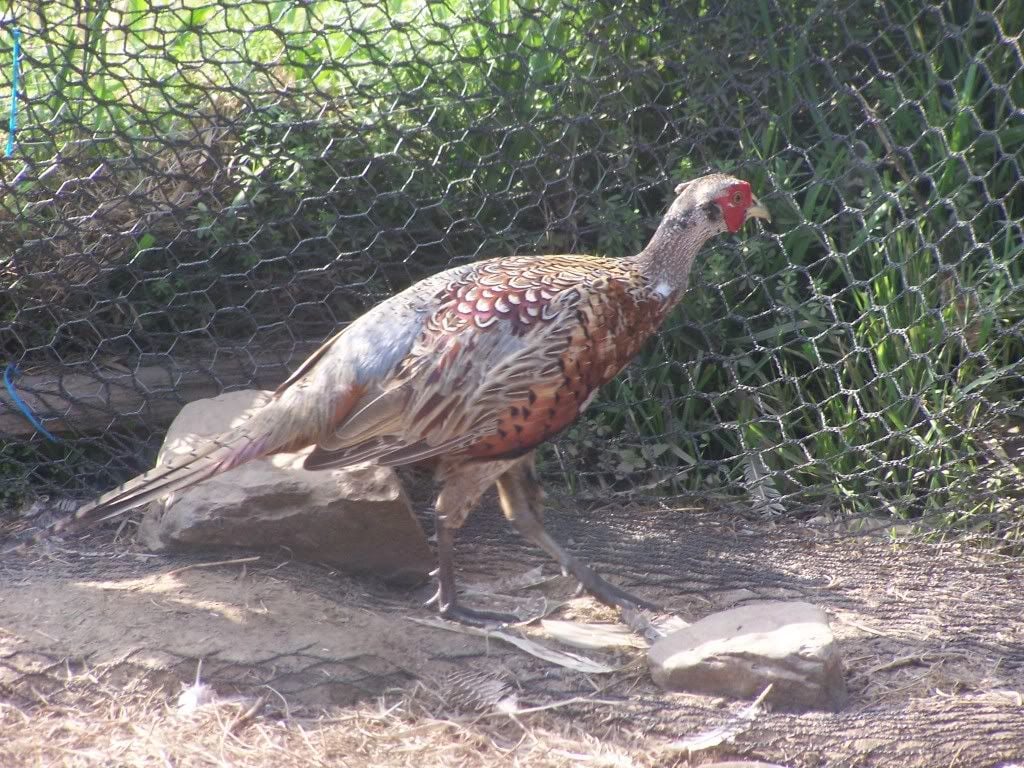
Sexing mature birds:
The males can easily be told from females as adults.
The male has:
-Bright red chest colors
-Red skin around the eyes called wattles
-Sharp pointy spurs
-larger body and a longer tail
-brighter colors on the body
The hens have:
-Brownish, buff colored bodies
-Smaller figure and shorter block tail
-More chick like in appearance
-No wattles
-No spurs
Diet:
The Ringneck Pheasant will eat a lot of things. In the summer, it is bugs, seeds, plants, and some crops. The winter is corn, wheat, and whatever they can find for food! Inn spring lots of bugs, seeds, worms, and grains are available. The fall is probably the season that they get the best food. Pumpkins, Apples, Sunflower seeds, Corn, and dried grains.
Eggs:
The eggs are a small, wide egg. They have a variety of colors that go from dark brown, to green, to an olive color. They are found during mating season, usually in late March or April:
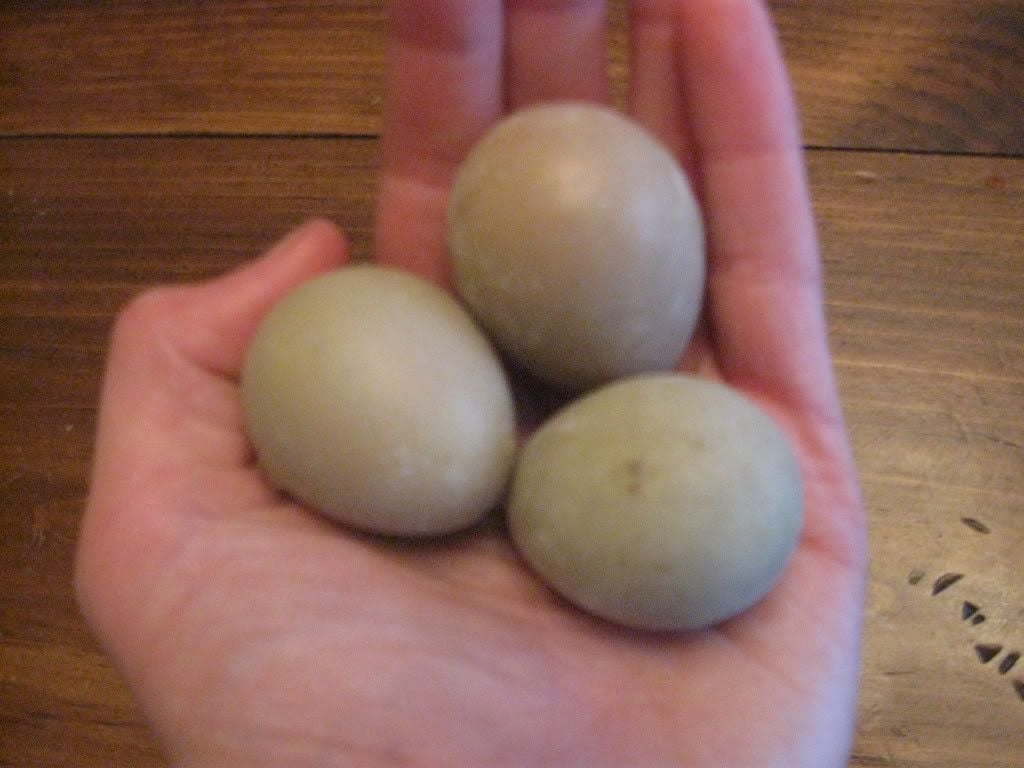
Here you can see the different colors:
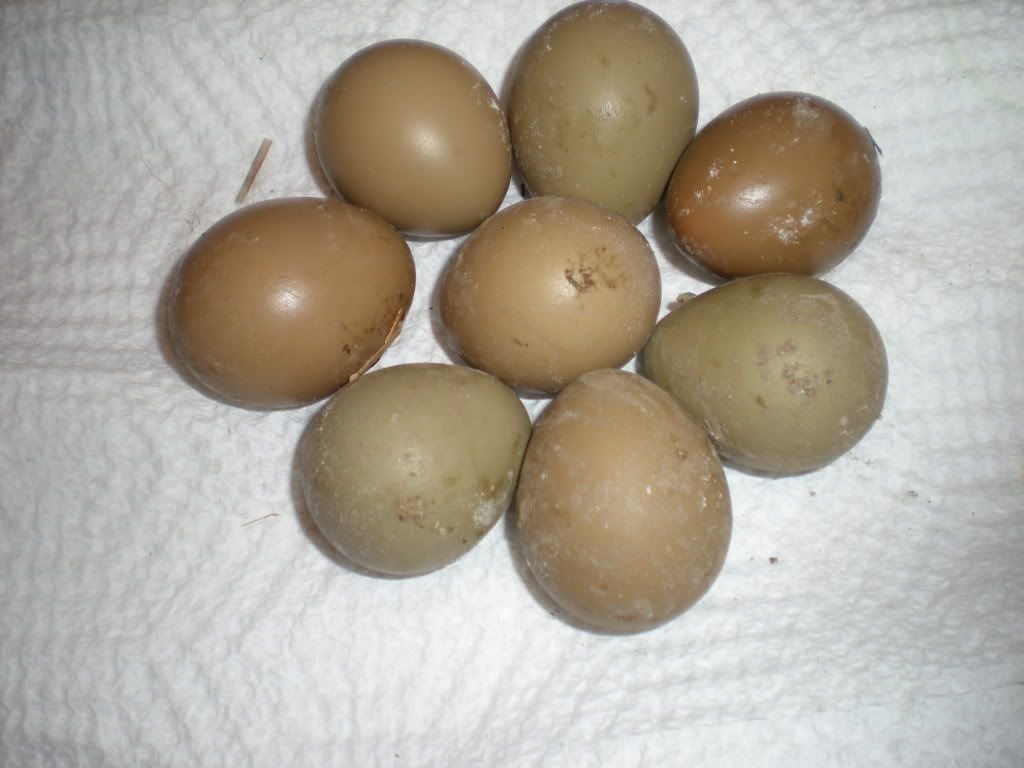
Pheasant photos by age:
Day old:
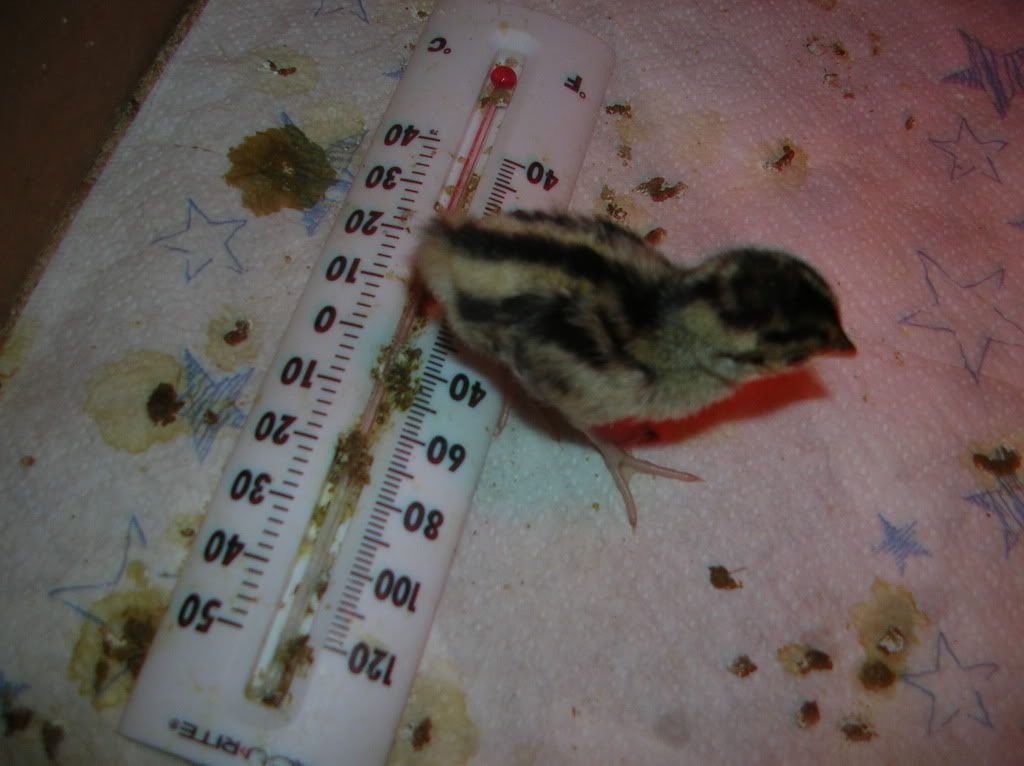
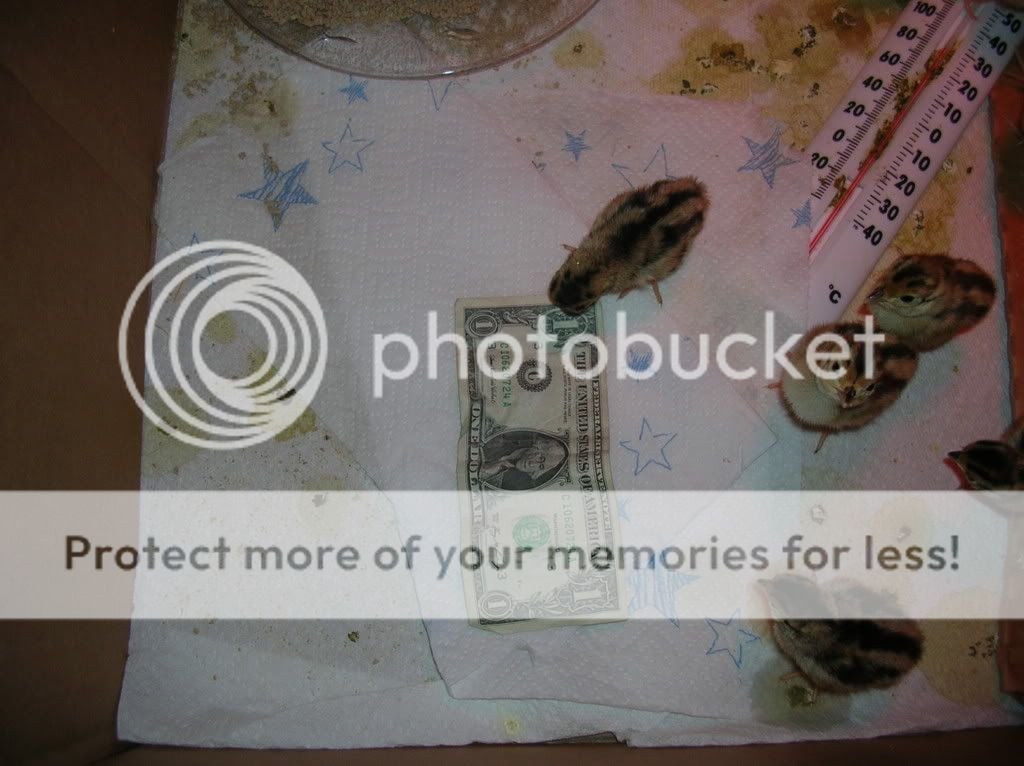
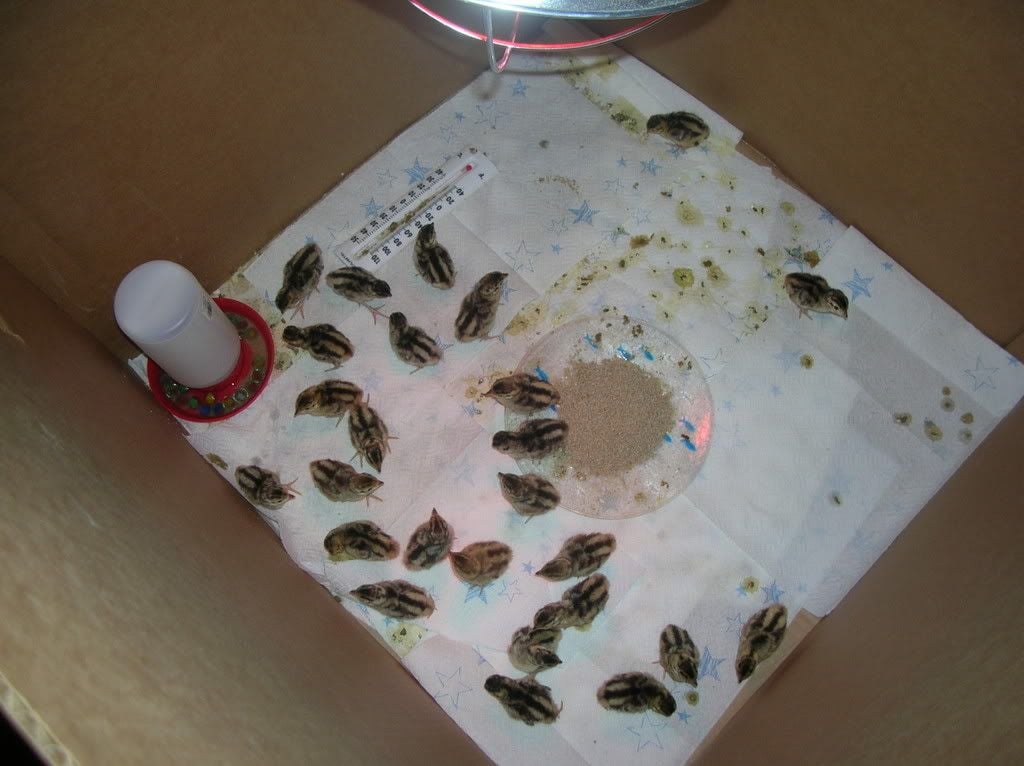
2 weeks old:
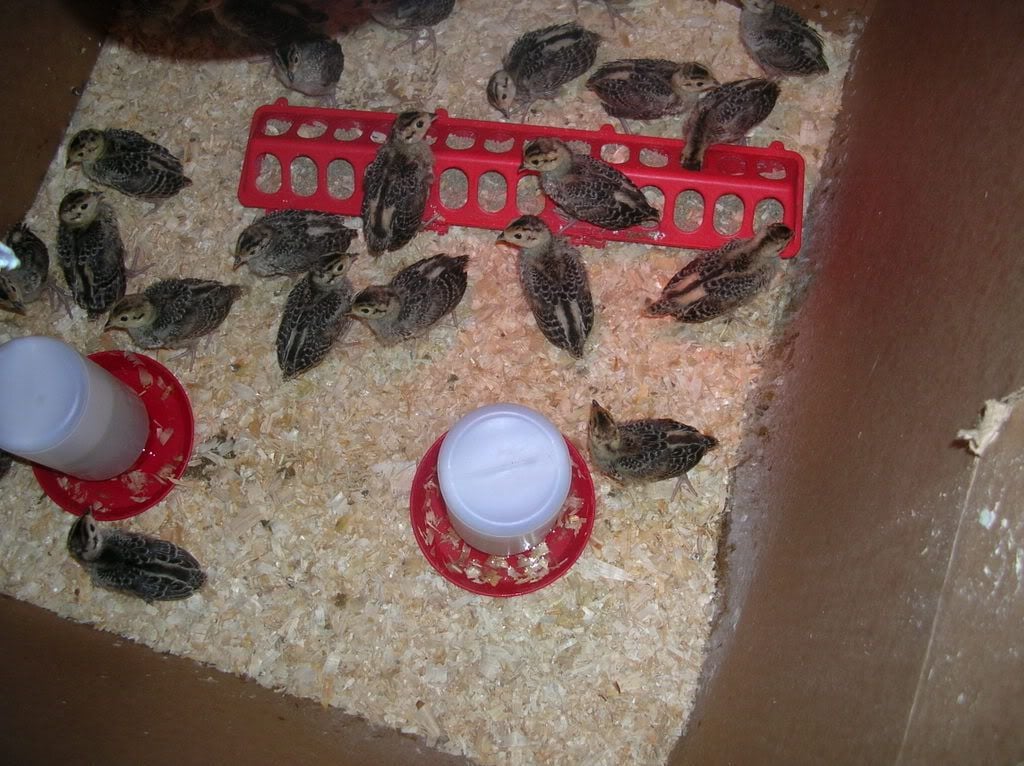
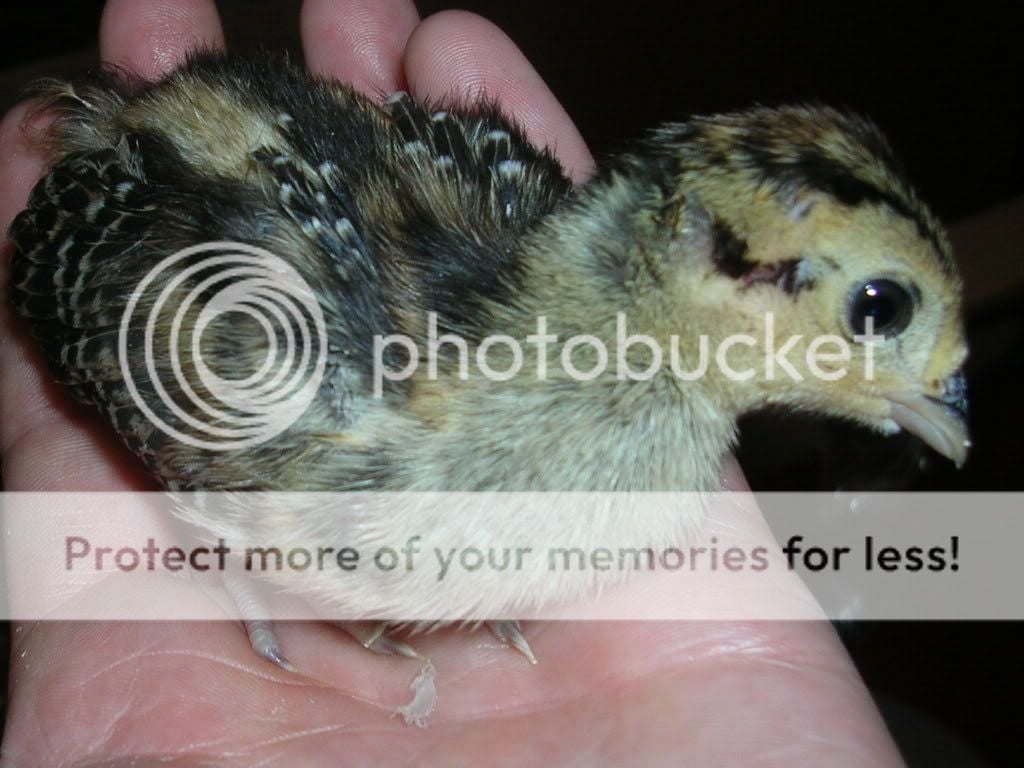
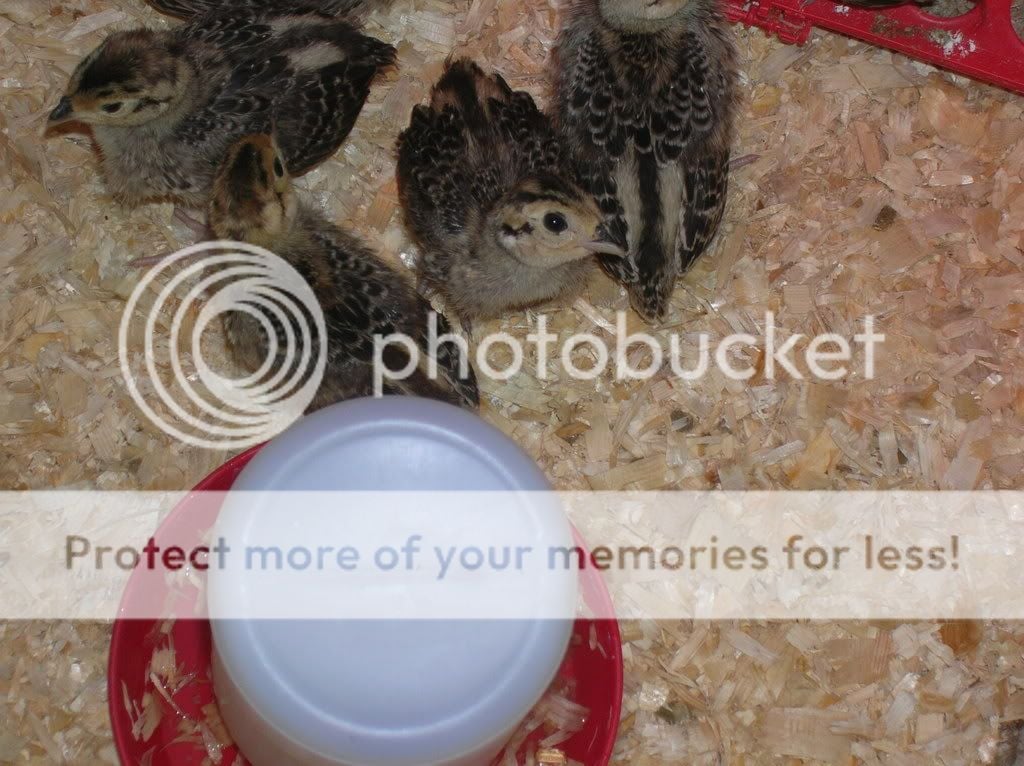
4 weeks old:

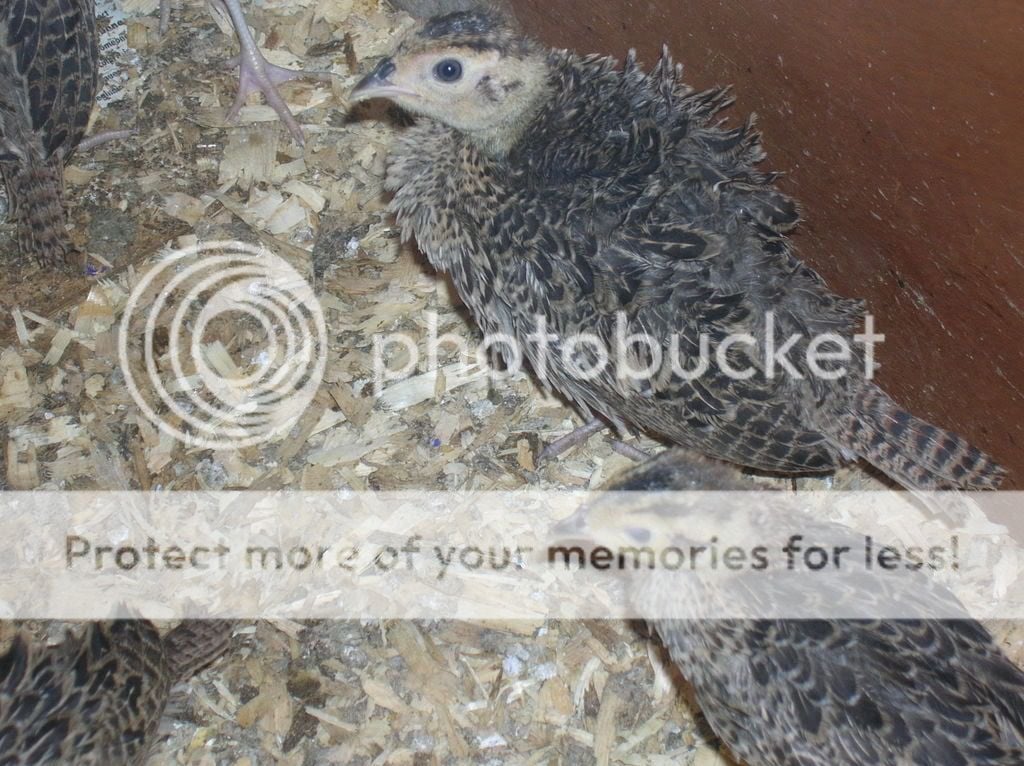
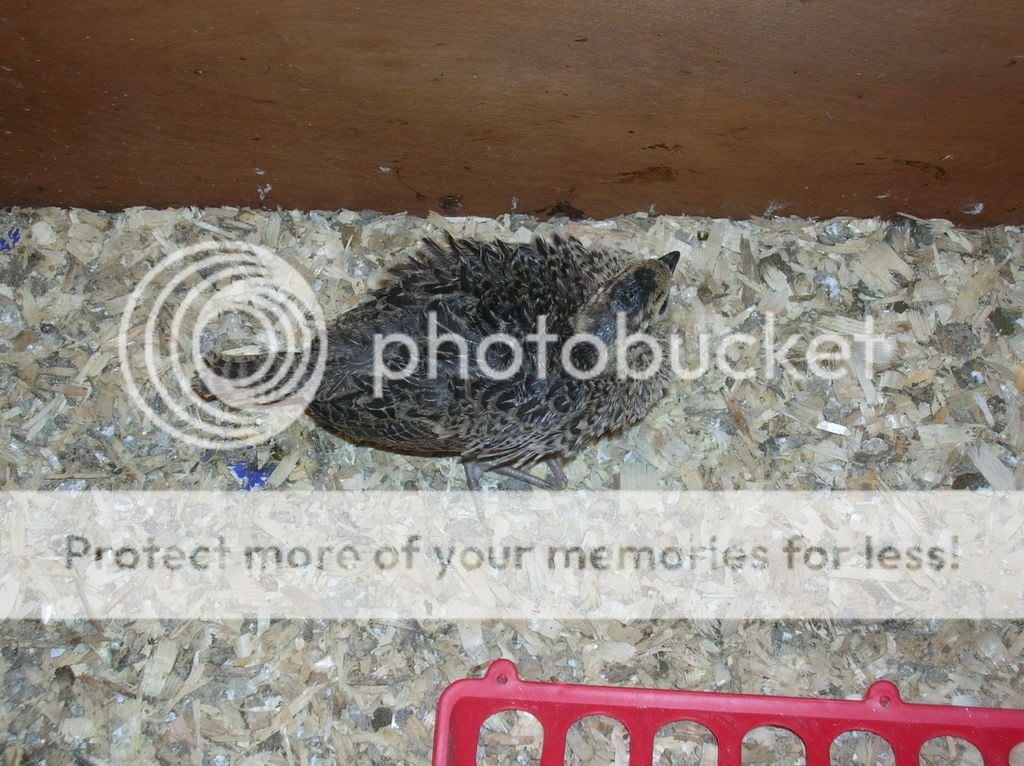
Jumping ahead a little bit... 10-15 weeks:

15-20 weeks:
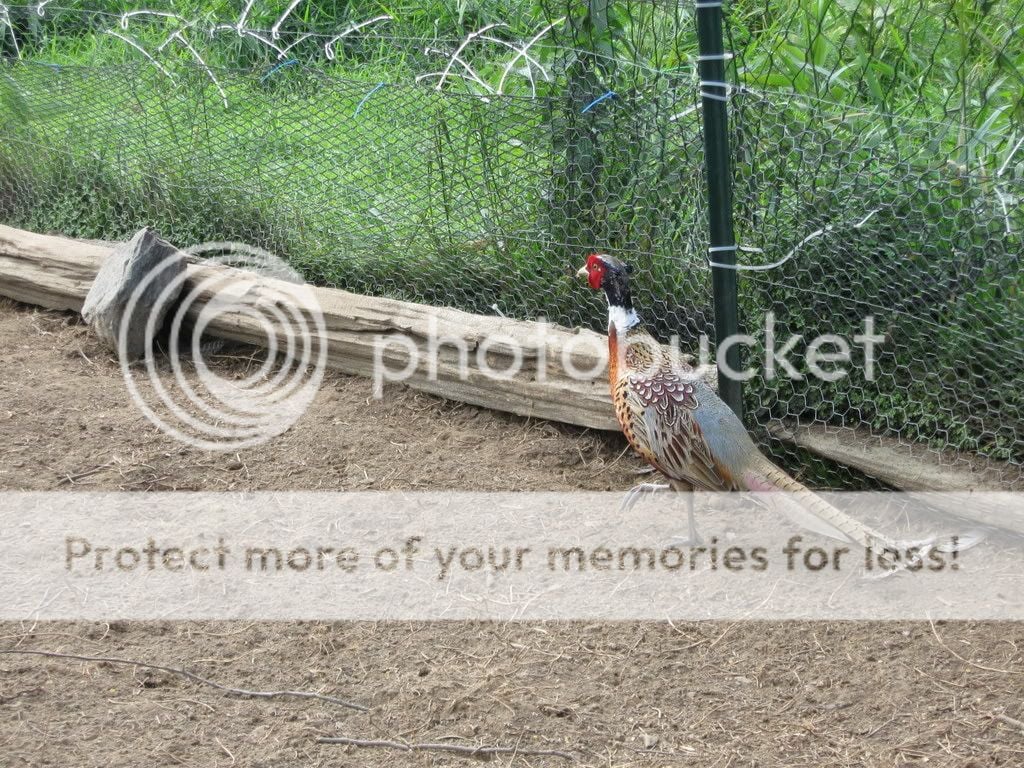
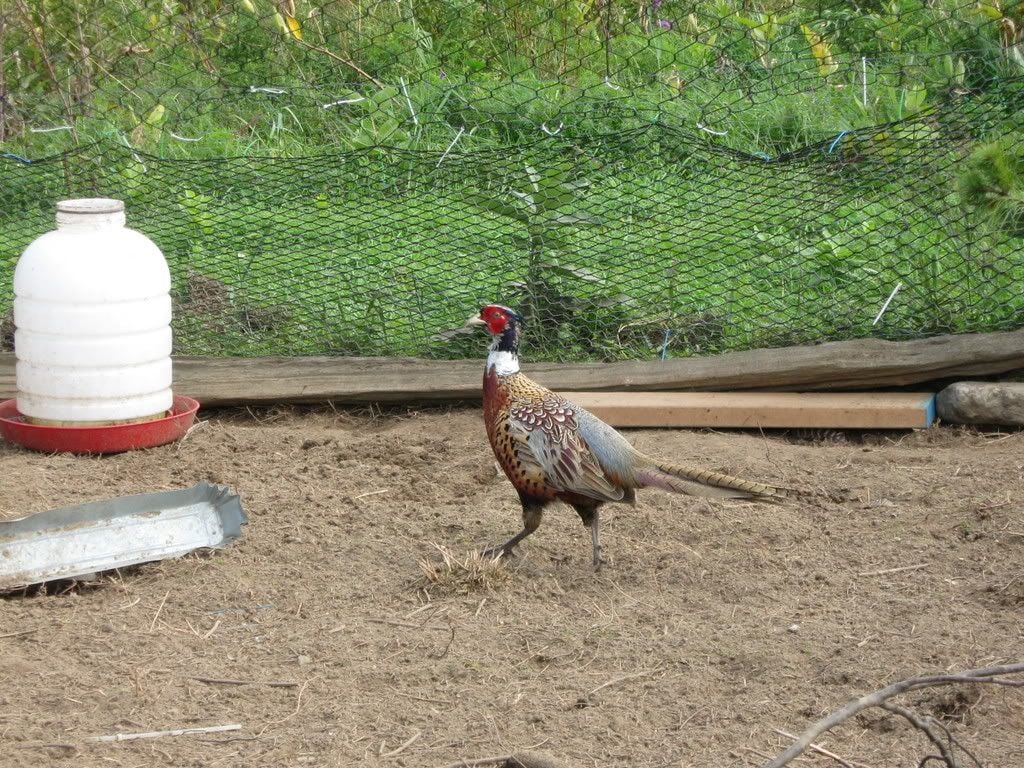
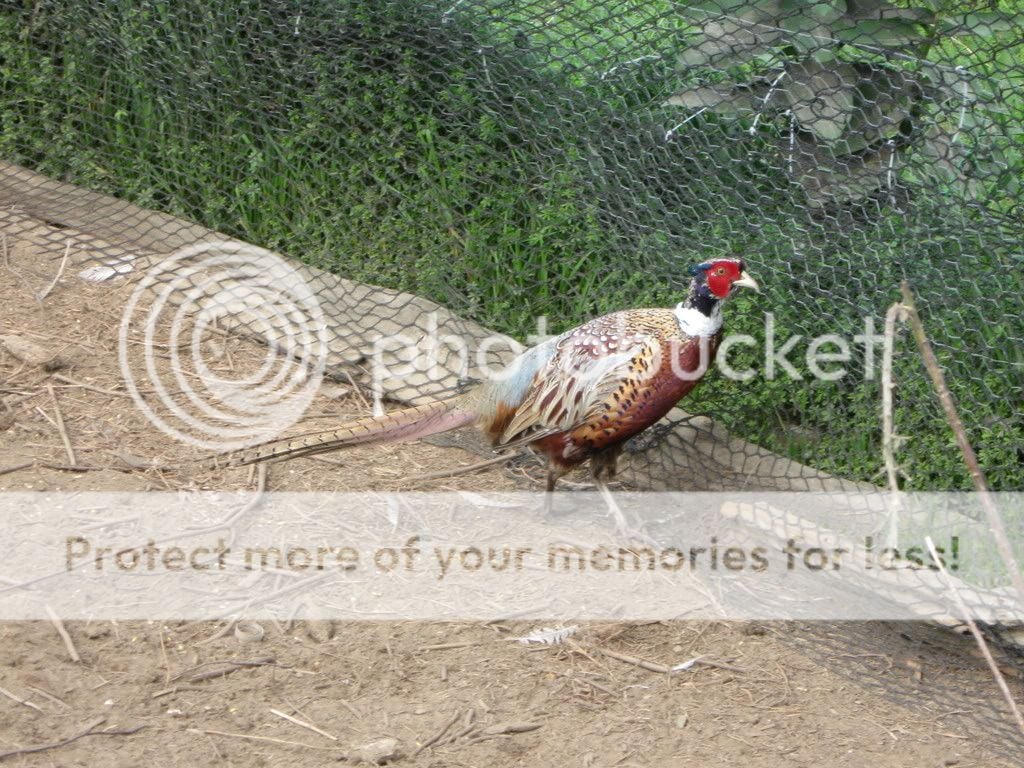
20-25:
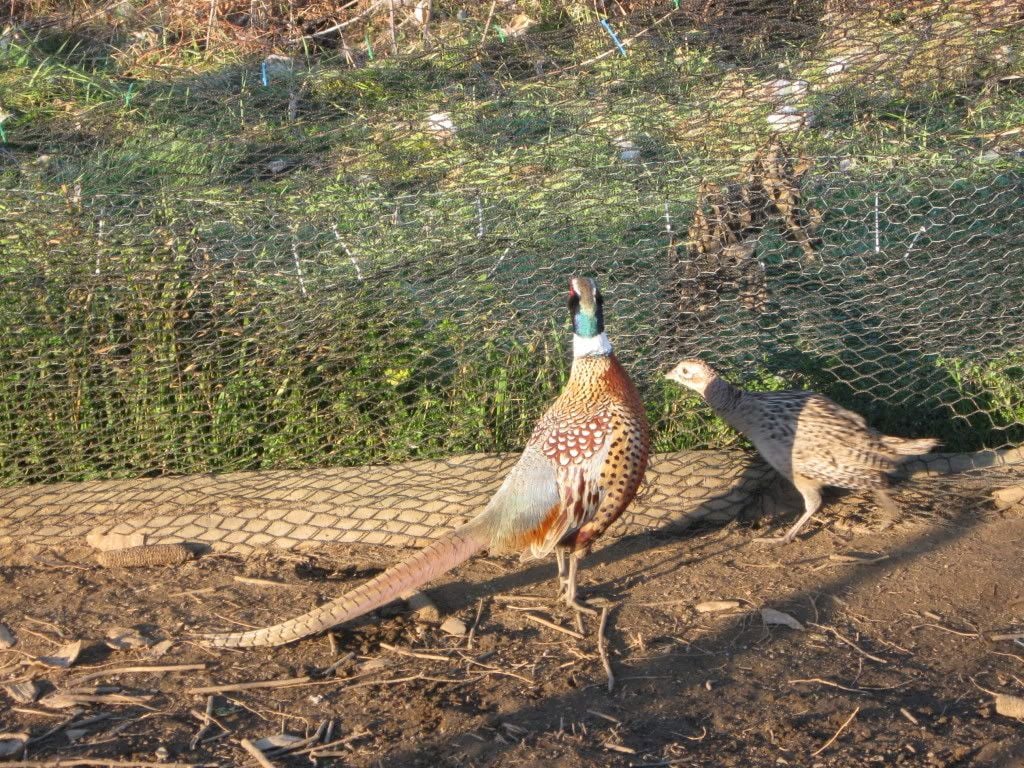
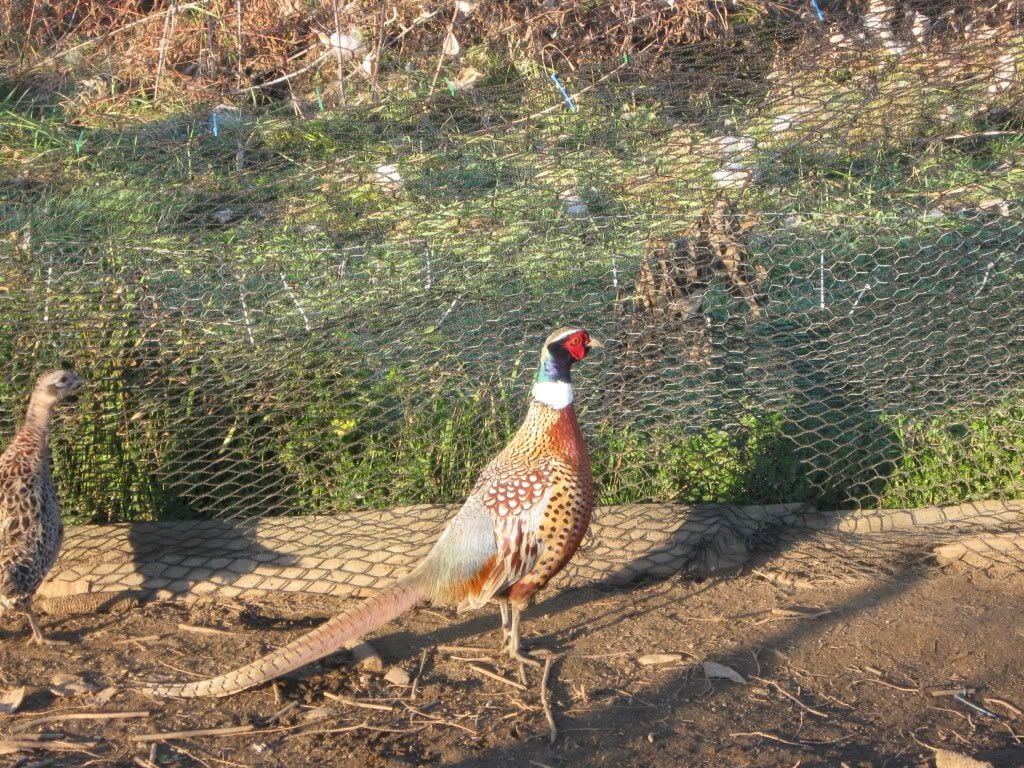
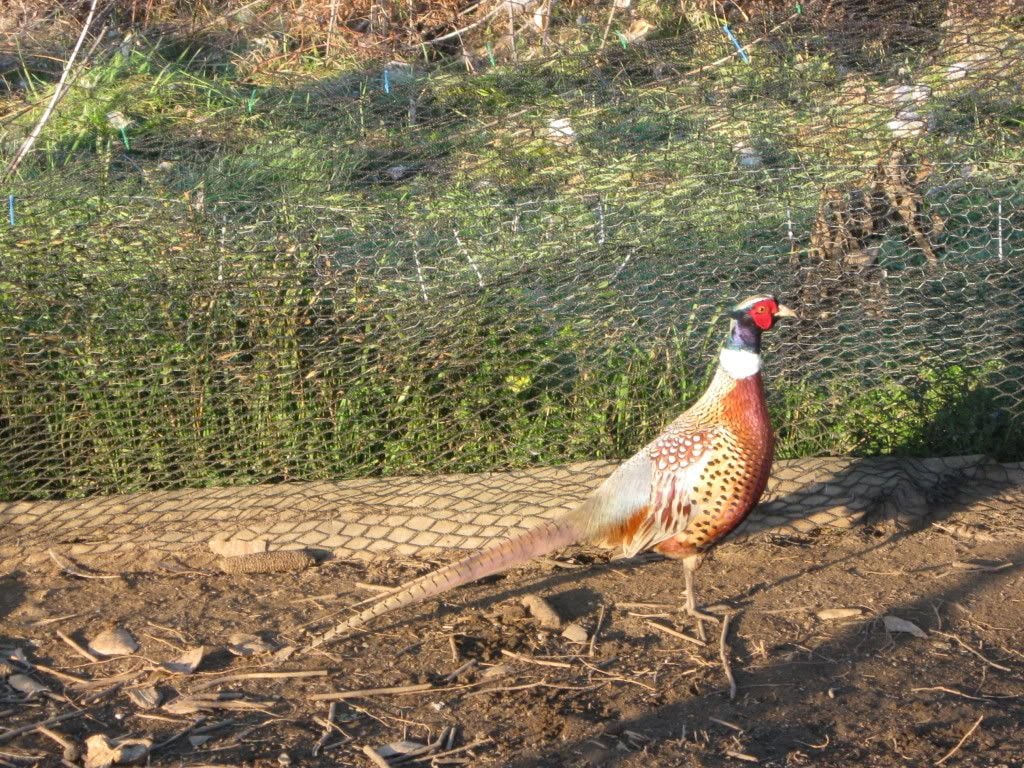
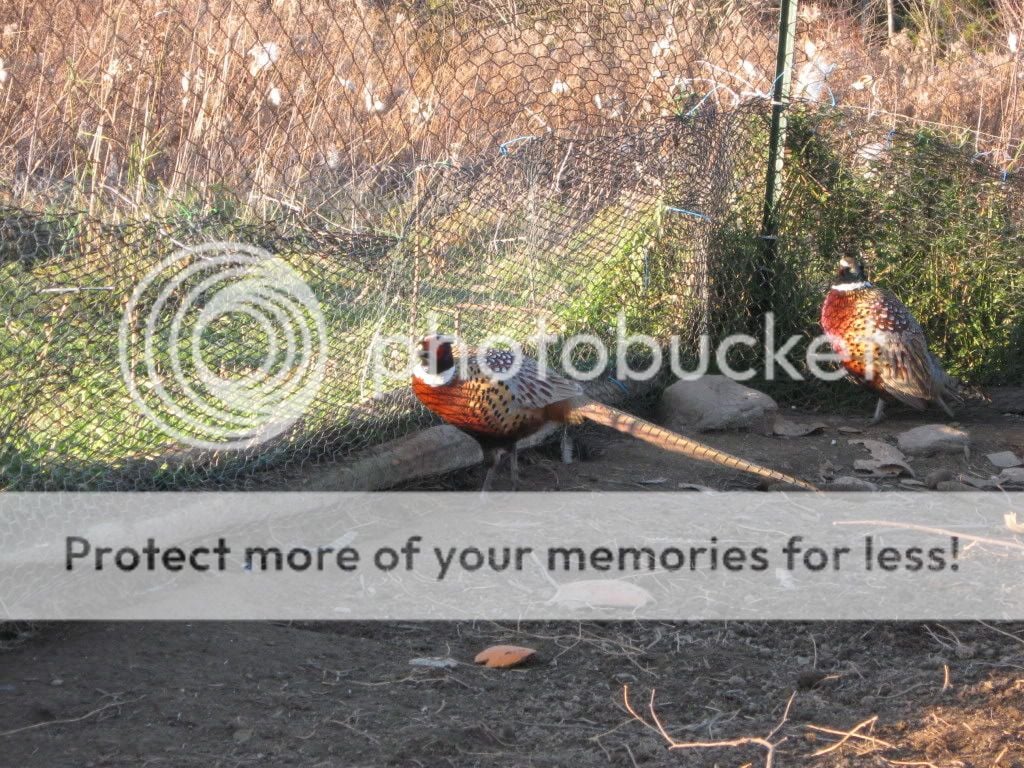
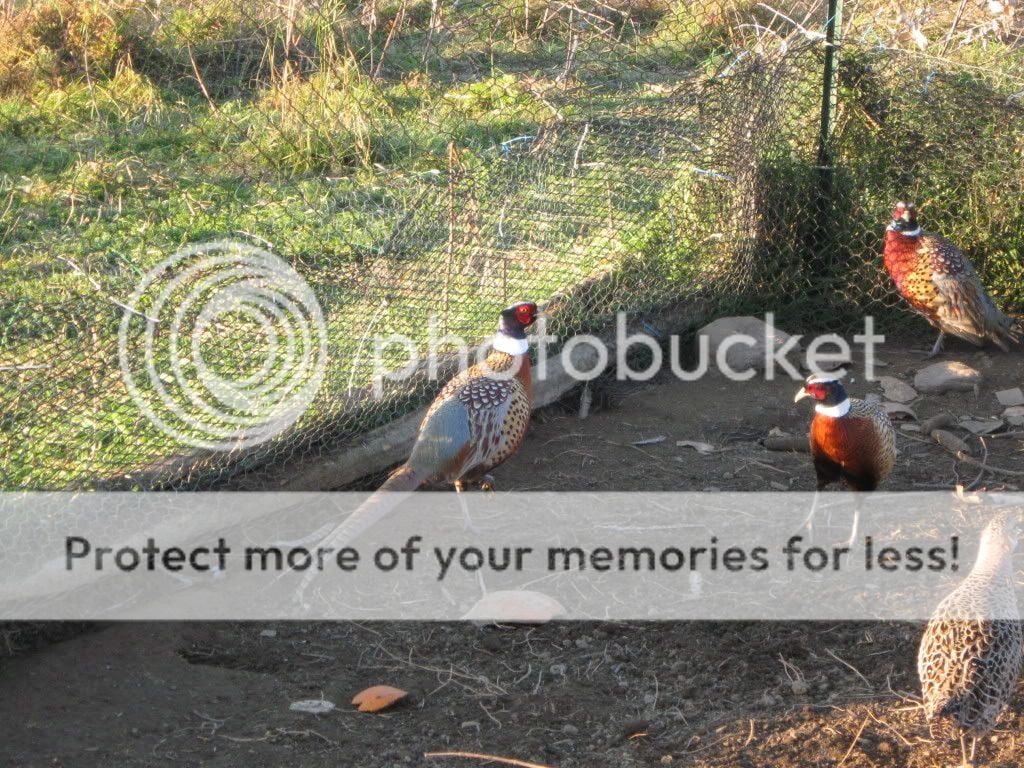
Unkown ages, 40+ weeks:
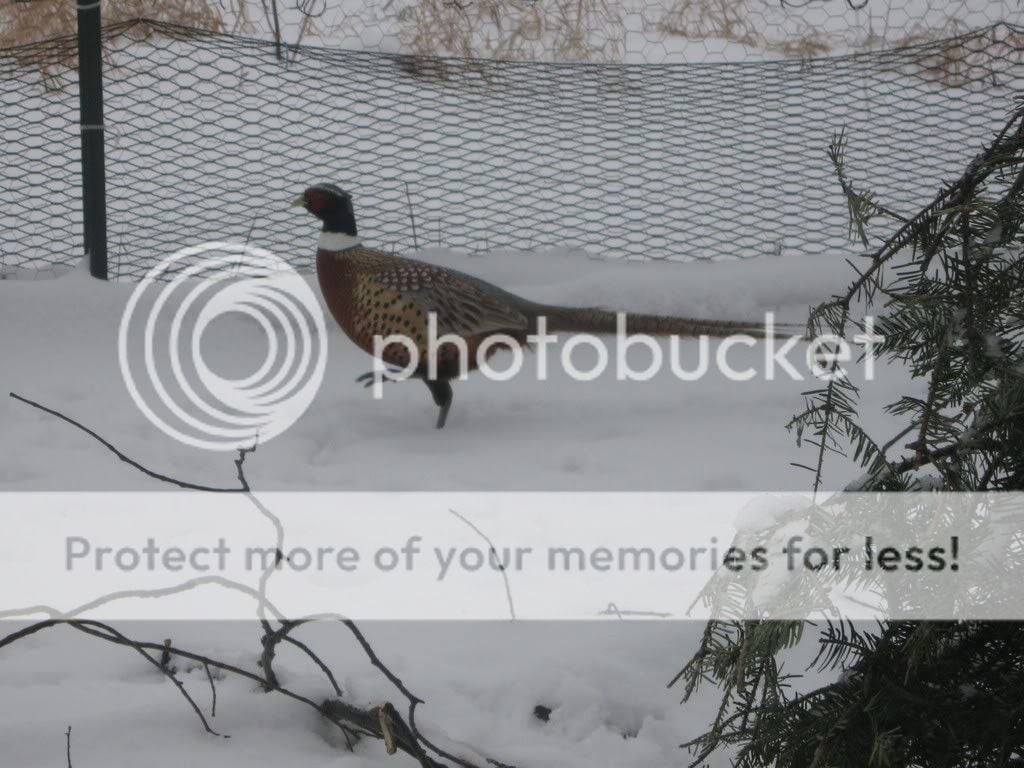
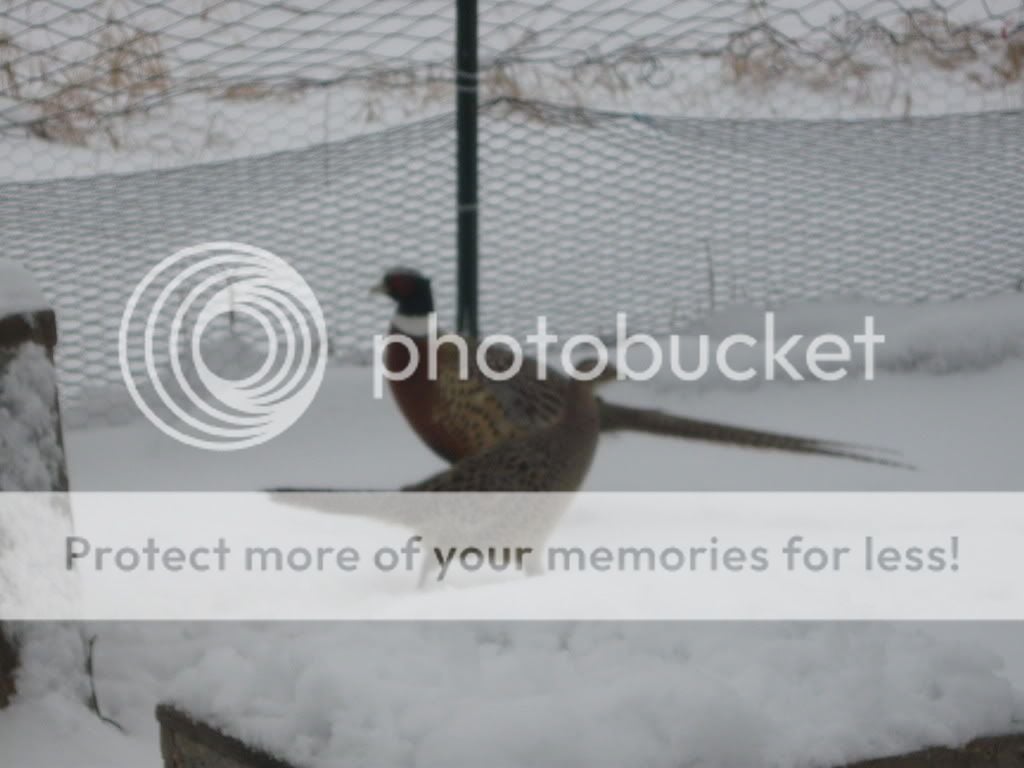
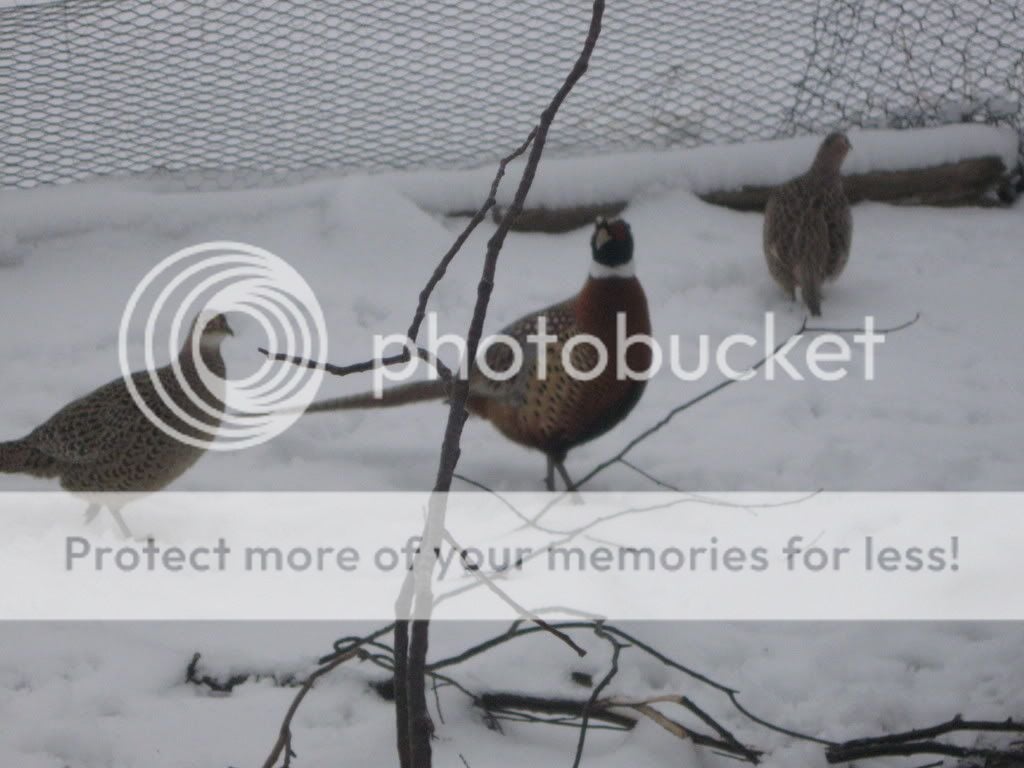
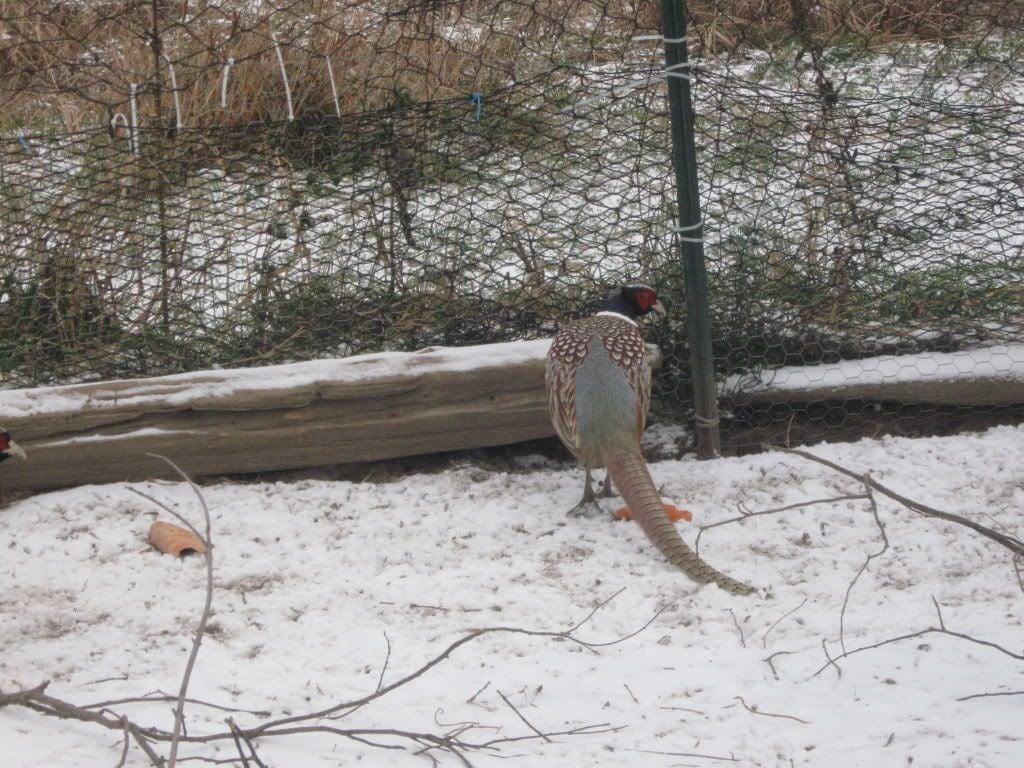
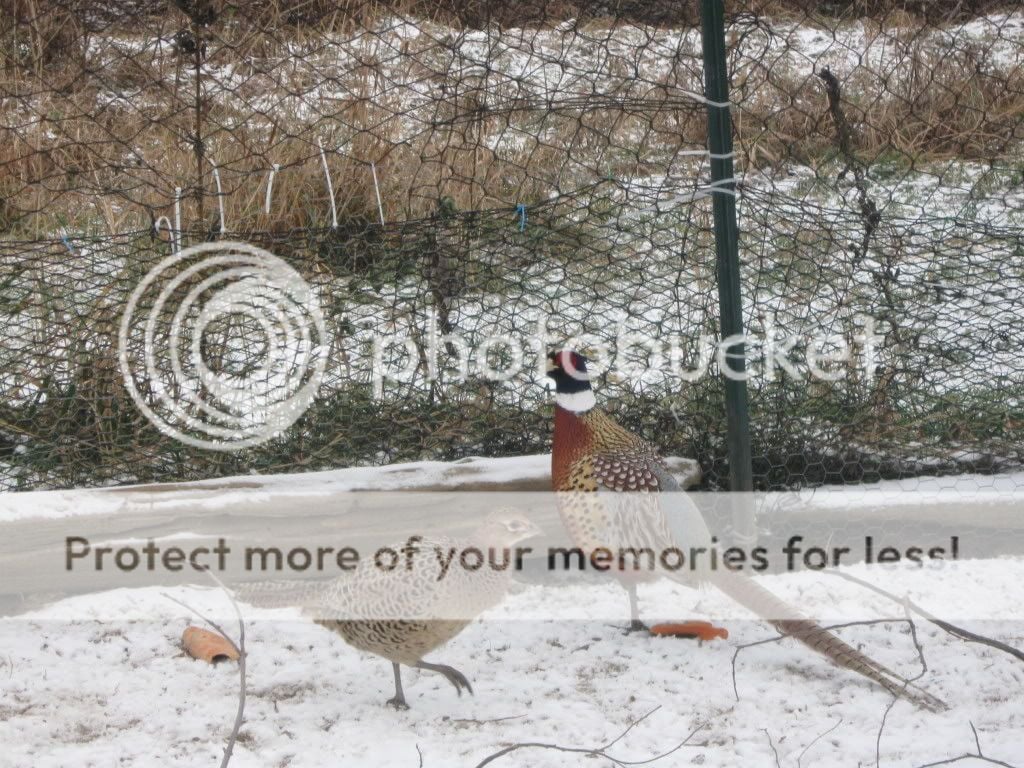
Very recent pictures, BREEDING SEASON ROOSTERS:
Note that this rooster is bulkier, deeper colors, deeper wattles, and looks larger, this is due to breeding season, (the extra roosters are not in that pen any more)
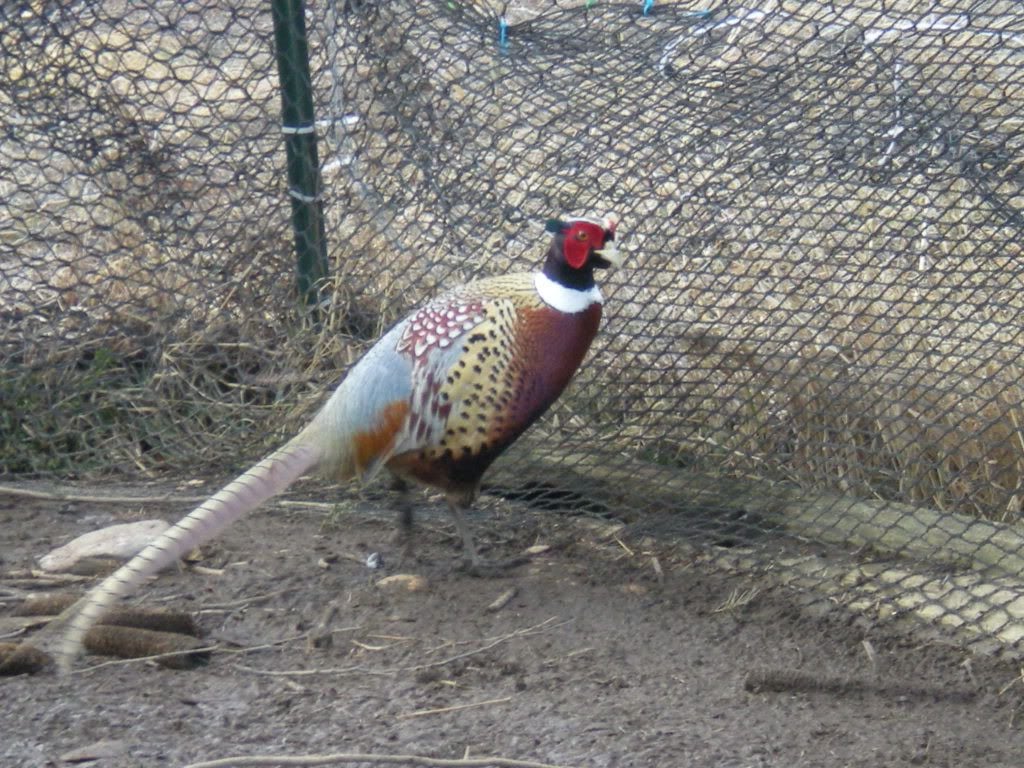
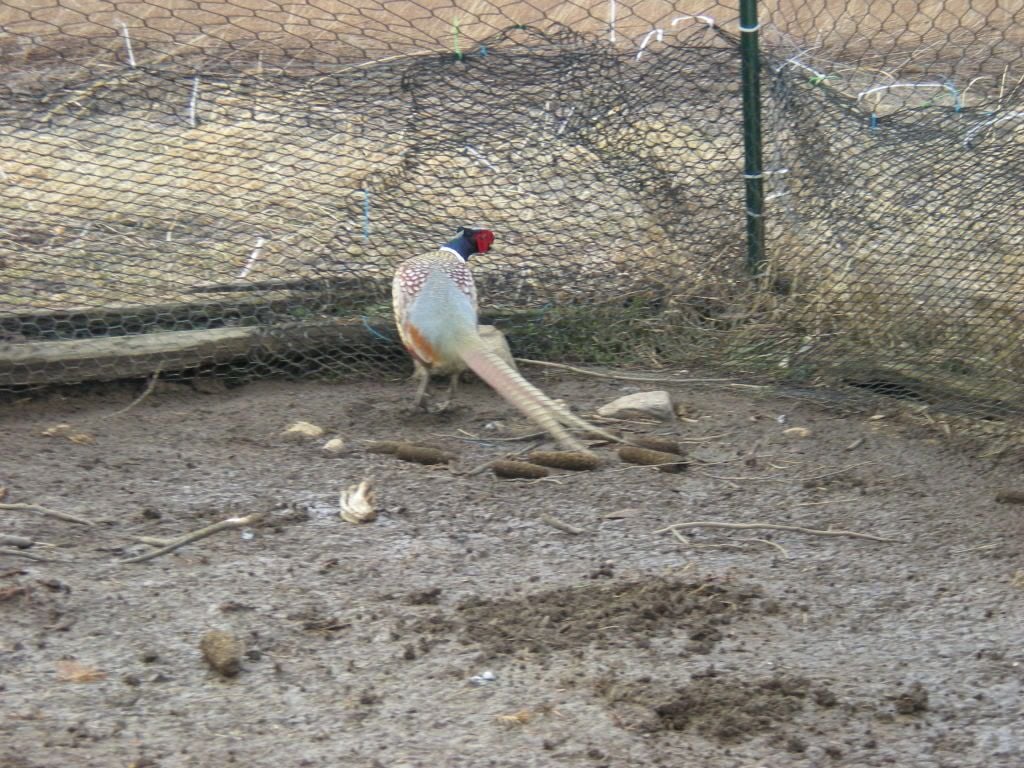
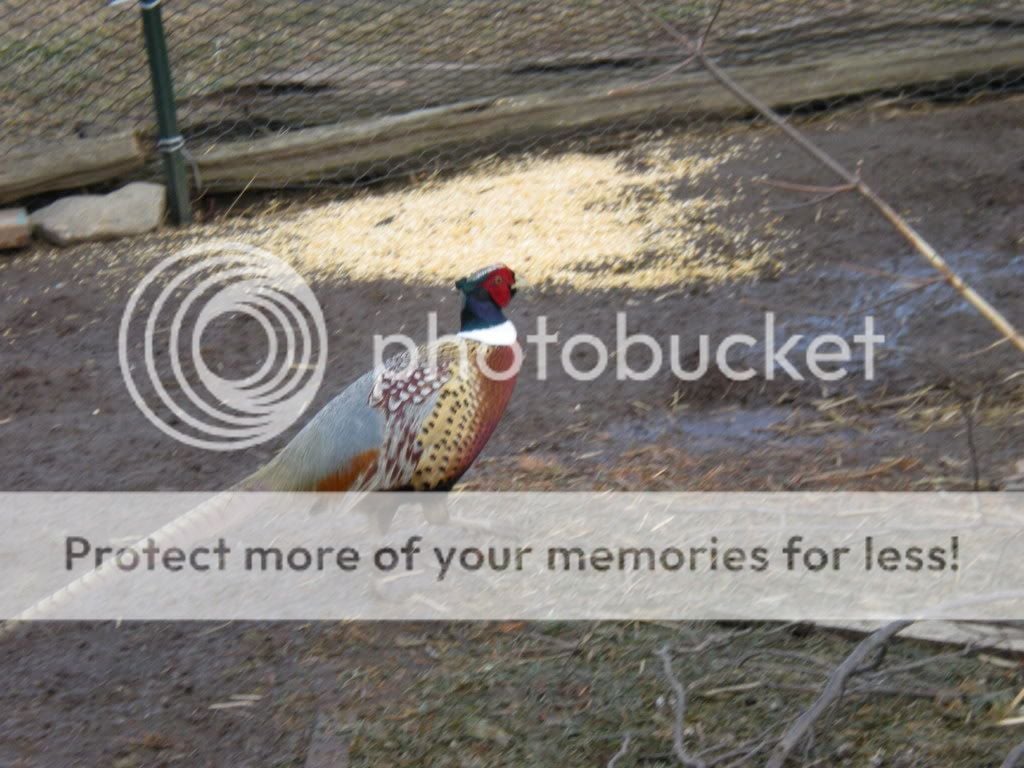
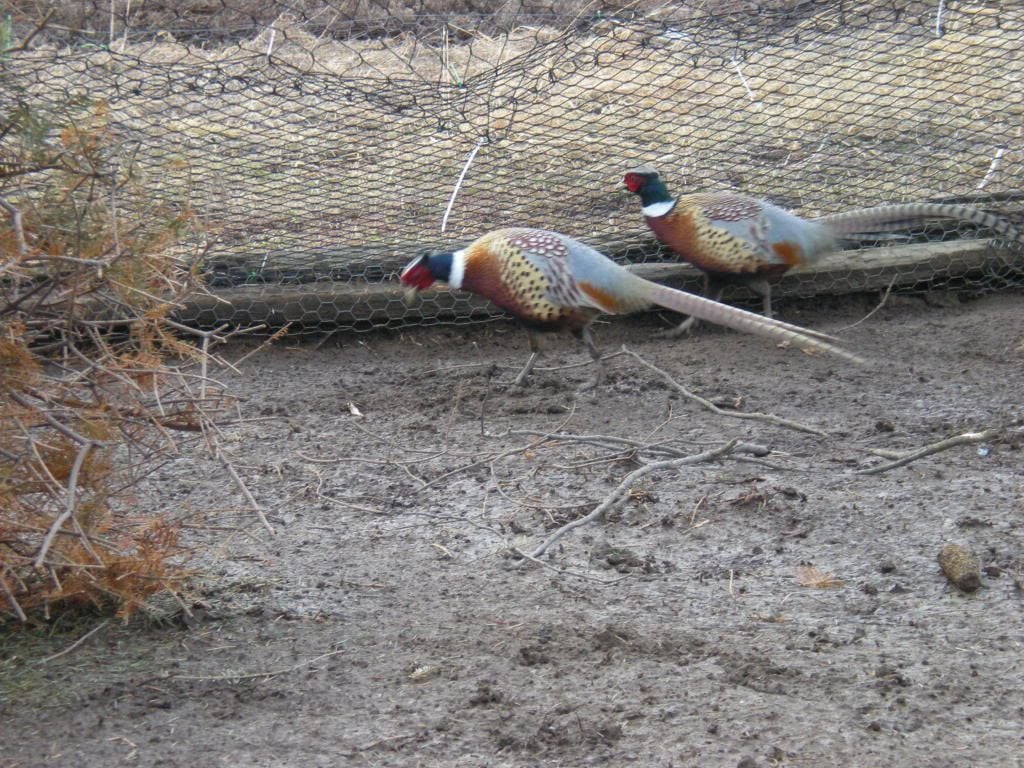
Some helpful raising tools:
-This is a blinder, or peeper used to stop aggressive roosters:
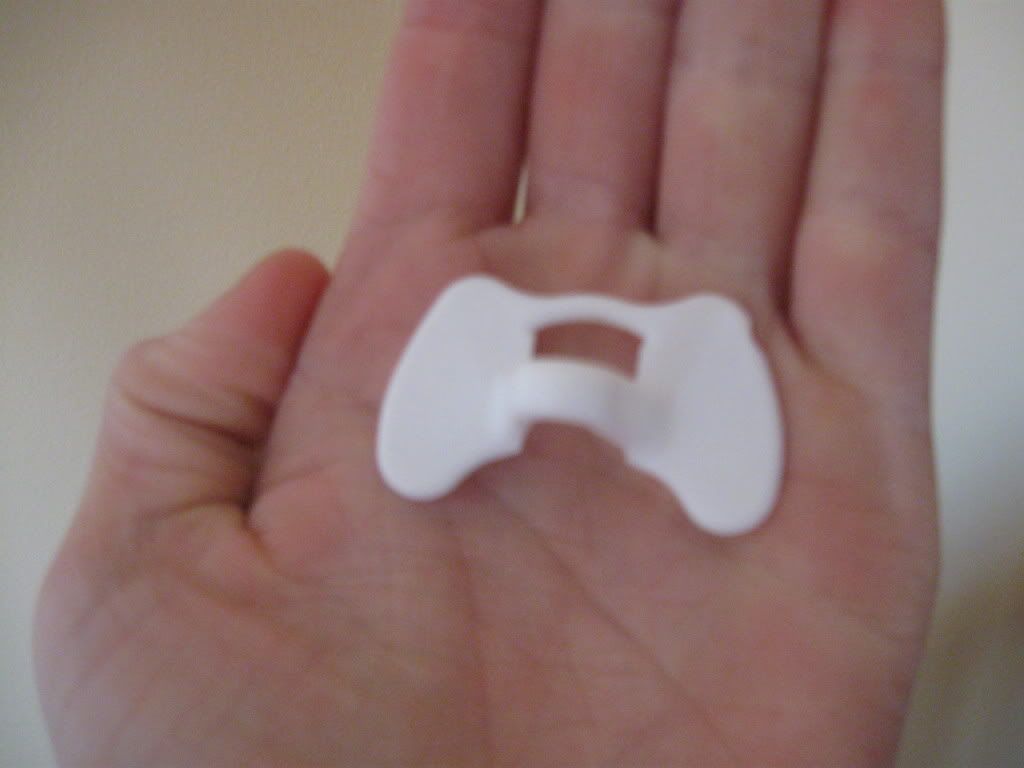
Winterizing Pheasants:
Although these birds are very winter tolerant, protection from wind and heavy snow is nrequired. I made little shelters out of doors, hay bales, and christmas trees. Other ideas are boxes, tubes used for drainage ditches, brush, and rocks.
Facts about pheasants:
-Although Pheasants are very explosive off the ground, the would much rather run and usualyl fly as a last resort, you can heara ditinct cackle created by the rooster when it takes off, another way to distinguish a male from a female. This is how they have adapted for captivity, in pens there is often no need to fly, which is what they like!
-Hens will usually lay low and will not fly until almost stepped on, this is due to the hens coloration. They are very "camoed out" and they know it, so they will hold tight until spotted. This is why so many hens sitting on nests are killed by tractors during the spring.
-Hens will seem to vocalize with eachother rather than with roosters, probably a dominance thing.
-Since birds cannot sweat, they will pant, do not be alarmed when you see your birds panting during a hot day or after they have flown.
-Roosters (or cockbirds) will dress out at about 4 pounds, while the hens stay at a petite 2-2.5 .
-During the growing season Pheasants can survive on water consumed by moisture in insects and morning dew on plants.
-In the winter, Pheasants can get water from the snow.
-Pheasant's most common predators are humans, foxes, skunks, raptors such as Owls, Hawks, and Falcons.
-By two weeks of age Pheasants can fly far enough to escape a tall brooder, or a predator.
-Pheasants are cousins two Quail and Partridge
Ringneck strains:
There are over 30 different subspecies of the Ringneck alone. Here are a few:
-Blue back
-Kansas (Which is a blue back)
-Mongolian
-Melanistic Mutant
-Chinese
-Jumbo
-White-Winged
-Green (Also called Japanese or Japanese Green)
-Manchurian cross
-Black-necked
-Formosan
sites:
http://www.ultimatepheasanthunting.com/
http://pheasantsforever.org/
http://www.gbwf.org/pheasants/phasianus_colchicus.html
http://www.pheasantchicksfarm.com/raisingpheasants.htm
if you have any questions not answered in this page I will try to answer them and put the info into this page.
History:
The Ringneck Pheasant (Phasianus colchicus) is a non-native animal to North America. They were imported from Asia (China) in the 1800's, but there were a few pairs of Blackneck Pheasants seen in 1733. Now, they are the most succesful non-native gamebird in America! They have adapted to life in the western states in large fields. The Ringneck was introduced into South Dakota in 1898, and can be recognized by many due to it's colorful plumage. Stocking efforts has kept this breed here to stay and efforts to preserving the land in which they live on.
Habitat:
Please look at this before you stock Pheasants into an area!
-EASTERN:
Pheasants will survive if there is substantial upland cover, known to hunters as "bird cover". Theses uplands need to be near or colose to swampy marsh areas, corn fields, and large ditches. In the North East, not many Pheasants make it through the winter as they are very tough for wildlife. Although, food plots planted for birds can help them survive harsh winters.
-WESTERN:
Western states have large fields of wheat, cover, food for winter, and all the essentials Pheasants need for surviving themselves. the large fields in the west provide both cover from predators and a lot of area to fly and/or run.
*Habitat needs*
- For nesting, brooding, and rearing in the wild hens need a medium to high grasses or crops
-Wetlands (as metioned above)
-Areas such as cattails, or switchgrass that will protect the birds from heavy snow.
-fields of Grains, Soybeans, Weeds, and crops to supply winter food. (this is why so many Pheasants stocked in east do not survive. Take note.)
Incubating Ringneck eggs:
Pheasants will begin to breed around March, the cockbirds will establish territories, fending off other males that want the same spot. A good ratio of cockbird to hens is 1:8, any more cockbirds will fight. Hens will lay with proper food (Layer pellet with corn ration, oyster shell free choice )
-The eggs will hatch better in a STILL AIR incubator as opposed to a forced air.
-Eggs in an incubator should be put in at 37.5*C, that was in my notes, so I haven't converted it to degrees Farenheit.
-Turning is required to prevent embryos from sticking from the side, Eggs that are hand turned should not be on the same side for two (2) consecutive nights on the same side.
-The humdity should be about 45-50%, and the birds will start hatching around the 24th day.
Raising Ringneck Pheasants:
(All information can be found on my website under Pheasant chick care)
-Heat. they like to be kept like chickens in about 90-95 degrees farenheit. make sure the chicks are not too hot; it could result in cannibalism. Also make sure they are not to cold. The could start piling.
-Space. Pheasant need a lot of space when they are young. If they are too crowded it could cause cannibalism. they need to .25 sq. feet for the first 2 weeks, 3-6 weeks .75 sq. feet per bird. Outdoor grow pens should give them about 15-20 sq.ft per bird.
-Water can be given in chick waterers. Make sure there are marbles in the waterers to make it shallow so the birds won't drown. Vitamins called terramycin can be put in the water if they are sick.
-Litter should be paper towels for the first week. After the first week they can be but on straw or pine shavings. Never use cedar, as it could kill the birds.
-food. Pheasant need a higher protein food. It could be a gamebird starter or just a higher percent protein. for my pheasant I use a 24%. some people use 28% I think 28% is better off for turkeys.
-Draft shields. draft shields are a circle that are put in the brooder to prevent piling in the corners. The draft shield should be a circle that is 2 feet in diameter for every 25 birds.
-At three weeks old they can range outside in a chicken wire pen during sunny days. Make sure the pen is covered so predators like hawks, coyotes, foxes, etc. can not get in, and so the Pheasant can't fly out. For this, I moved my pheasants into a pen in the garage, on nicer days I would open the garage door so they could get some fresh air.
-Red heat light. The birds get very aggresive if the have a bright light shining on them so it is a good idea to have a red 250 watt heat lamp.
-Turning off the light on sunny days will help a few things. 1.) It will help prevent any fighting going on. 2.) Help the pheasant get used to the idea of no heat. 3.) Save you money on your electicity bill.
-Going into the flight pen. At 6-8 weeks of age the Pheasant can go into the flight pen. Just make sure there is the proper cover needed.
Cannibalism:
Canniblism is very common in gamebirds like pheasant. If it is not caught in it's early stages it could be very bad later on. A good way to prevent cannibalism is to have enough space ofr them, have just the right tempature, and have a red heat lamp. My Pheasant started to become cannibalistic between 5-7 weeks. It stopped once we put them outside into the flight pen.
Note the blood on the wings, this was ten minutes after we put them into the pen:

Flight Pens:
Flight pens are key to the pheasants survival in the wild. Flight pens should be made out of a mesh type of netting called flight netting. The pen should be big enough to give each pheasant 20-30 square feet of space. It should have enough cover (brush, shelters, tree branches, rocks, etc.) to protect it from the weather or predators that might get into the pen.
Pictures of my flight pen:



Releasing:
Pheasants should be released when they are matured, and are smart enough to be out in the wild without being killed. A good rule of thumb (Personal opinion) is when they have almost full green heads, around 20ish weeks.
About this age:

Telling gender at younger ages:
I saw with my birds that usually wattles will appear on a rooster around 9 weeks old, they grow quickly once they start, in a few weeks wattles turn to feathers, to green heads, then to longer tails.
Pheasants can also be sexed a hours old by patches under the eye, I have not seen how to do this yet. This bird is around 10-15 weeks old :

Sexing mature birds:
The males can easily be told from females as adults.
The male has:
-Bright red chest colors
-Red skin around the eyes called wattles
-Sharp pointy spurs
-larger body and a longer tail
-brighter colors on the body
The hens have:
-Brownish, buff colored bodies
-Smaller figure and shorter block tail
-More chick like in appearance
-No wattles
-No spurs
Diet:
The Ringneck Pheasant will eat a lot of things. In the summer, it is bugs, seeds, plants, and some crops. The winter is corn, wheat, and whatever they can find for food! Inn spring lots of bugs, seeds, worms, and grains are available. The fall is probably the season that they get the best food. Pumpkins, Apples, Sunflower seeds, Corn, and dried grains.
Eggs:
The eggs are a small, wide egg. They have a variety of colors that go from dark brown, to green, to an olive color. They are found during mating season, usually in late March or April:

Here you can see the different colors:

Pheasant photos by age:
Day old:



2 weeks old:



4 weeks old:



Jumping ahead a little bit... 10-15 weeks:

15-20 weeks:



20-25:





Unkown ages, 40+ weeks:





Very recent pictures, BREEDING SEASON ROOSTERS:
Note that this rooster is bulkier, deeper colors, deeper wattles, and looks larger, this is due to breeding season, (the extra roosters are not in that pen any more)




Some helpful raising tools:
-This is a blinder, or peeper used to stop aggressive roosters:

Winterizing Pheasants:
Although these birds are very winter tolerant, protection from wind and heavy snow is nrequired. I made little shelters out of doors, hay bales, and christmas trees. Other ideas are boxes, tubes used for drainage ditches, brush, and rocks.
Facts about pheasants:
-Although Pheasants are very explosive off the ground, the would much rather run and usualyl fly as a last resort, you can heara ditinct cackle created by the rooster when it takes off, another way to distinguish a male from a female. This is how they have adapted for captivity, in pens there is often no need to fly, which is what they like!
-Hens will usually lay low and will not fly until almost stepped on, this is due to the hens coloration. They are very "camoed out" and they know it, so they will hold tight until spotted. This is why so many hens sitting on nests are killed by tractors during the spring.
-Hens will seem to vocalize with eachother rather than with roosters, probably a dominance thing.
-Since birds cannot sweat, they will pant, do not be alarmed when you see your birds panting during a hot day or after they have flown.
-Roosters (or cockbirds) will dress out at about 4 pounds, while the hens stay at a petite 2-2.5 .
-During the growing season Pheasants can survive on water consumed by moisture in insects and morning dew on plants.
-In the winter, Pheasants can get water from the snow.
-Pheasant's most common predators are humans, foxes, skunks, raptors such as Owls, Hawks, and Falcons.
-By two weeks of age Pheasants can fly far enough to escape a tall brooder, or a predator.
-Pheasants are cousins two Quail and Partridge
Ringneck strains:
There are over 30 different subspecies of the Ringneck alone. Here are a few:
-Blue back
-Kansas (Which is a blue back)
-Mongolian
-Melanistic Mutant
-Chinese
-Jumbo
-White-Winged
-Green (Also called Japanese or Japanese Green)
-Manchurian cross
-Black-necked
-Formosan
sites:
http://www.ultimatepheasanthunting.com/
http://pheasantsforever.org/
http://www.gbwf.org/pheasants/phasianus_colchicus.html
http://www.pheasantchicksfarm.com/raisingpheasants.htm
if you have any questions not answered in this page I will try to answer them and put the info into this page.
Last edited:



